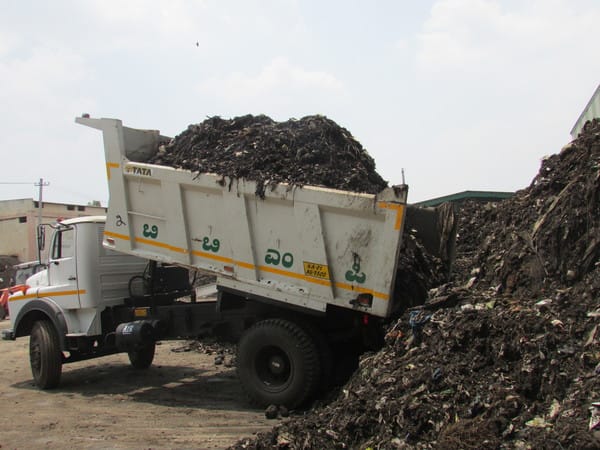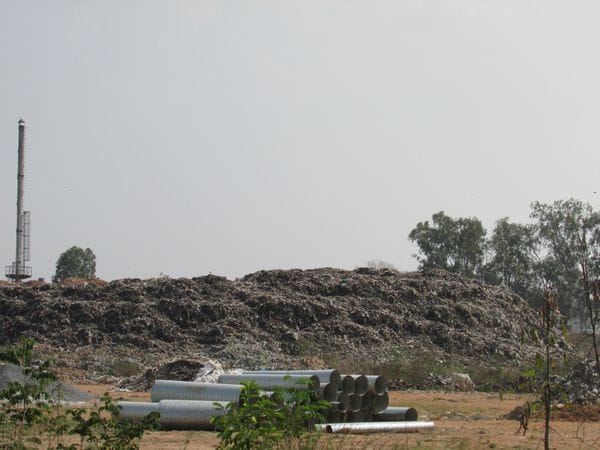It was a hot mid-afternoon on March 22nd, 2017 – just a few days after the residents of Somasundarapalya and surrounding areas called off their protest demanding the closure of Karnataka Compost Development Corporation (KCDC) waste processing plant – that I visited this plant in Bengaluru. Days after the protest, the work had resumed at the waste processing plant and trucks were lined up to unload waste collected from Bommanahalli and BTM Layout constituencies.
It was business as usual at the KCDC plant – a four-decade-old wet waste composting unit developed on a six acres of land (total area owned by KCDC is 32 acres) adjacent to Somasundarapalya lake in Kudlu.
A truck unloads half-processed waste at the KCDC waste processing plant in Kudlu. Pic: Akshatha M
I stopped a truck carrying waste that had just entered the plant. This particular truck had arrived from Bommanahalli. I asked the driver about the nature of the waste inside the truck – was it mixed waste or pure wet waste? He confidently said, “it’s pure wet waste.” Pointing at the huge quantity of dry waste piled up in the premises, I further probed him. “Isn’t this plastic and other dry waste lying around, the result of mixed waste that trucks bring to the plant?” And he replied, “we used to bring mixed waste, but not anymore. They (KCDC supervisors) send the trucks back if we bring mixed waste.”
I followed the truck as it made way through the heaps of processed and under-process waste, and entered the shed where the fresh waste was dumped. As the truck began unloading, it was a pleasing sight to see. Waste and pleasant? Well, I call it a pleasing sight because the waste coming out of the truck was largely wet waste, unlike a lot of dry mixed waste piled up around. Same with the truck that came in next – it was largely kitchen and vegetable waste.
Soon after, a young man appeared carrying a small tank and began spraying something over the fresh waste. The liquid they were spraying – the culture – or micro-organisms, was meant to accelerate the decomposition of organic waste, to control foul smell and flies and to treat leachate. Next to the fresh waste was huge piles of old waste set for windrow process. (Windrow processing is made by piling biodegradable waste in long rows of 5 ft by 4 ft with a gap of 3 ft between each row).
There were no rows of waste inside the shed. An earthmover machine was making space for the waste within the shed, shuffling and moving the waste. I asked a supervisor there, “Is the windrow happening?” He said the process was yet to begin. They were working on making space for the old and new waste and removing the leachate.
RDF dumped in KCDC premises. Pic: Akshatha M
Meanwhile, the labourers at the plant were busy with their daily tasks. Some of them were spraying the culture on the dumped waste and others operating waste filtering machines. They wore no masks or gloves – health and hygiene appeared to be the least of their priorities.
One of the staff at KCDC casually put it, “Madam, we have been working here from last 15-20 years. We never faced any skin problems despite working in the plant. Stench is the only issue and we are used to it.” Though he sounded as if he was speaking on behalf of all the staff and workers at KCDC, I could not ascertain his claims.
Of bio-filter and other systems
On the other end of the plant, there was a mound of old mixed waste turned over and brought down for decomposition (windrow) process. Around 16,000-18,000 tons of old waste (according to KCDC) is waiting to be processed in the KCDC premises from past three years. The KCDC began receiving mixed waste after Mandur dumpyard was closed in 2013. Of the 1.5 lakh tons of mixed that the KCDC received in 2014, around 18,000 tons of waste remains to be processed, while the rest has been processed.
As I was taking a stroll around the processing unit, I spotted a man switching on a machine just outside the plant. When I asked him what it was, he said it is the bio-filter system. Bio-filter, when it was launched last year, was touted as first of its kind project that would help reduce the stench in the composting unit.
On closely observing the functioning of bio-filter system I realised that it was a futile attempt at odour control. The machine placed on the one side of the plant sucks fresh air from outside and sends it into the plant through huge pipes hanging from the roof of the shed. Another set of pipes suck the stench filled air from the shed, and release it to four tanks constructed on other side of the shed. These tanks are filled with coir and enzymes which kill the stench-generating bacteria. But the major loophole in this entire exercise is, the shed is not sealed. There is enough open space in the shed including doors and windows which freely let out the stench.
Why not seal the shed to make it more efficient? I asked one of the KCDC staff. And his reply reflected the bad planning of authorities. “Sealing the shed would make it impossible for workers to breath. Lack of enough fresh air would be suffocating,” he explained.
KCDC had spent Rs 5 crores on bio filter.
Bio-filter pipes attached to the waste processing shed carry stench filled air to the tanks. Pic: Akshatha M
Leachate and plastic management
As I stepped out of the waste processing plant, I came across a tank half filled with leachate. Leachate! Yes, the same smelly liquid that percolates from the mass of waste. KCDC had a few months back come under fire for letting the leachate into the nearby Somasundarapalya lake.
The day I visited the plant, the leachate tank was half-filled. There was no leachate overflowing from the tank or flowing on the ground inside the shed. The supervisor at the plant said they had already sent a tank full of leachate to one of the BWSSB’s Sewage Treatment Plant (STP). I followed the drain that connects to the lake just to check if the leachate flows to the lake. The drain was almost dry and the leachate wasn’t let into the lake that day.
As I walked further, I could see mounds of waste rejects in KCDC premises – mostly plastic. These rejects have been dumped here for years, with nothing much done to convert them into Refuse Derived Fuel (RDF).
The issue of the countless tons of rejects remains unsolved.
The heavy microbial filtering machines of 60 mm, 30 mm, 10 mm and shredding machines installed in the premises were all functional. They were converting the decomposed waste into manure – the black manure which is sold to farmers across the State.
Also see: Can of worms opens up after govt composting firm sells garbage as vermicompost
What’s wrong with KCDC?
KCDC plant at Kudlu claims credits for being the only functioning plant among 13 such composting plants in India which were established as per the Central government’s order way back in 1970s.
I spent a few hours at KCDC plant observing the work taking place and talking to the staff and workers, to get a first hand knowledge of what is happening at the controversial waste composting plant. This wet waste processing plant has been receiving brickbats from the residents of the neighbourhood, ever since it resumed functioning and started receiving fresh waste in 2014.
Three years on, the tug of war continues. While the people residing near the plant have staged protests many times under the umbrella of Kudlu, Haralukunte, Hosapalya, Somasundarapalya, Parangipalya (KHHSP) Residents’ Welfare Association, demanding the closure of the plant, the government has been firm on not closing it down.
Every time the residents protested, the Bruhat Bengaluru Mahanagara Palike (BBMP) and the State government have been assuring the residents of taking measures to control the stench emanating from the plant. The question that the elected representatives and officials often pose at those demanding the closure is – what is the alternative to KCDC? Where else the city’s wet waste be composted?
New methods of odour control that didn’t really work
The KCDC, which earlier used to make use of cow dung-based slurry to control the odour emanating from the waste and leachate, later on shifted to lemongrass-based culture for leachate and stench control. When the stench became uncontrollable, the BBMP and KCDC decided to install the biofilter at a cost of Rs 5 crore. These biofilters were expected to extract bad smell from the waste processing unit and are released to a pit.
When the biofilter installation took longer than expected, KCDC resorted to a temporary solution of using an odour control technology from Canada. Around Rs 10 lakh was spent on this imported spraying system that was supposed to give out a fruit fragrance. But that also failed.
Now although the biofilter system is in place, it has not really helped in controlling the odour. The KCDC officials admit that the system has not been effective, due to the large open space in the processing units, which lets the stench out. Glass windows are yet to be fitted to seal the shed for air suction.
If stench forms one part of the problem, the plant receiving mixed waste in place of wet waste, excess generation of leachate, of it flowing to adjacent Somasundarapalya lake and polluting the surface water and groundwater, thousands of tons of old and new rejects dumped in the KCDC premises, of the Refuse Derived Fuel (RDF) catching fire, form other problems.
So what did the BBMP do to control the situation? Let’s get into it in the next part of this series.
Disclaimer: This reporter’s random visit to the KCDC plant to do a reality check happened a month ago, in March 22nd, 2017. The story is based on the reporter’s observations on that particular day. The scenario at KCDC might be different on other days.


